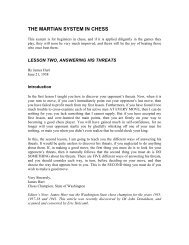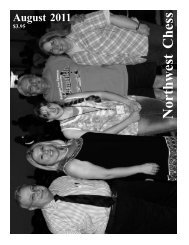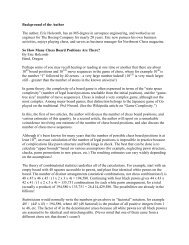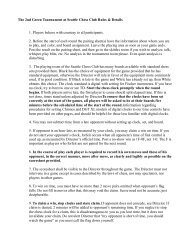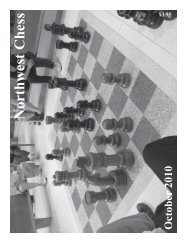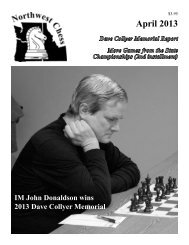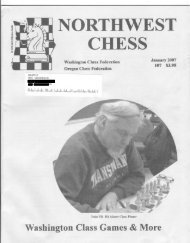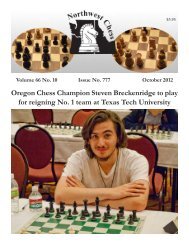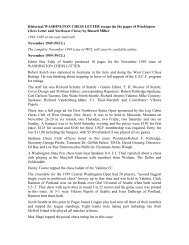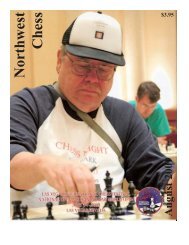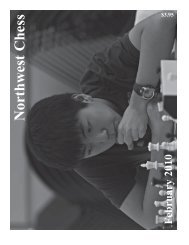April 2009
April 2009
April 2009
Create successful ePaper yourself
Turn your PDF publications into a flip-book with our unique Google optimized e-Paper software.
{The black f-pawn is looking like a<br />
monster and is well supported by the black<br />
pieces. White (correctly) decides to sac his<br />
knight for it rather than let it continue to<br />
exist.}<br />
Black ‘solidifies’ his defense of f5 and<br />
opens up the second rank for his queen,<br />
which seems like a sensible idea. However,<br />
solid also means rigid, and the e6 pawn<br />
impedes his bishop. This allows White’s<br />
attack to increase in force. Correct was 34...<br />
Nd6. If White continues as in the game with<br />
35. h4 (35. gxf5 Rg5 is fine for Black) then<br />
Black can exchange pawns, since his f6 rook<br />
is defended by the pawn: 35... fxg4 36. Rxf6<br />
exf6 37. N3xg4 Bxg4 38. Nxg4 Rg6.<br />
35. h4 Nd6 36. g5 Rfg6<br />
37. R1f2<br />
In time pressure White missed his best<br />
chance 37. Nxg6 Rxg6 38. Ng4! with a<br />
winning attack.<br />
37. ...Qe7 38. Rg2 Bd7 39. Nxg6 Rxg6<br />
40. Rf1<br />
40. gxh6! Rxg2 41. Kxg2 Ne4 42. Nf1<br />
Be8 43. Qf3 Qf8 44. Ng3 Qxh6 45. Nxe4<br />
dxe4 46. Qg3 is also very complicated.<br />
{White made time control with less than<br />
a minute to spare. Black had five minutes.}<br />
40. ...Be8 41. Qf3 Ne4 42. Qf4 hxg5<br />
43. hxg5 Rxg5 44. Rxg5 Qxg5 45. Qxg5<br />
Nxg5 46. Kg2 Kg7 47. Kg3 Bg6 48. Rh1<br />
Ne4+<br />
49. Kf3<br />
{Much better than 49. Kf4! Nf2<br />
followed by ...Nd3 and Black is liking his<br />
position.}<br />
49. …Kf6 50. Rh2 Kg5 51. Ng2 Nd2+<br />
51. ...Bh5+ 52. Ke3 Nf6 (threatens a<br />
fork) 53. Rh1 Ng4+ 54. Kd2 Nf6 and Black<br />
has set up a strong fortress.<br />
52. Ke2 Ne4 53.<br />
Ke3 Ng3 54. Rh8<br />
Nh5 55. Rb8<br />
Much better was<br />
the prophylactic<br />
maneuver 55. Ne1!<br />
f4+ 56. Kf2 Bb1 57.<br />
Nf3+ Kg6 58. Rb8<br />
with a clear<br />
advantage for White.<br />
55. ...f4+ 56. Kf2<br />
Nf6<br />
57. Nxf4!<br />
This exchange leads to a clear draw. 57.<br />
Ne1 was still correct, though Black has the<br />
initiative for a while 57. …Ng4+ 58. Ke2<br />
Bh5 59. Nf3+ Kf5 60. Kd2 Nf2 61. Ne5 +=<br />
57. ...Kxf4 58. Rxb6 Ng4+ 59. Ke2<br />
Bd3+ 60. Kd2 e5 61. dxe5 Nxe5 62. Rf6+<br />
Ke4 63. Rxa6 Nf3+ 64. Kc1 d4 65. a4 Bf1<br />
{Threatening to get a passed d-pawn.}<br />
66. cxd4 Kxd4 67. Rf6 Bg2 68. a5 Ne5<br />
69. a6 Nc6 70. Rf7 c3<br />
{Likely continuation is 71. bxc3 Kxc3 72.<br />
a7 Nxa7 73. Rxa7 would be a K + R vs. K +<br />
B. While it’s true computers have<br />
demonstrated that that ending is a forced<br />
win in 227 moves with PERFECT play, it’s<br />
usually a draw with humans considering the<br />
50 move rule.} [editor – Corey is making a<br />
little joke here.]<br />
1/2-1/2<br />
[editor – The business card below should<br />
now read, “Current and 4-time Oregon<br />
Champion.” Congratulations, Carl!]<br />
<strong>April</strong> <strong>2009</strong> Northwest Chess Page 23



